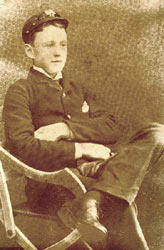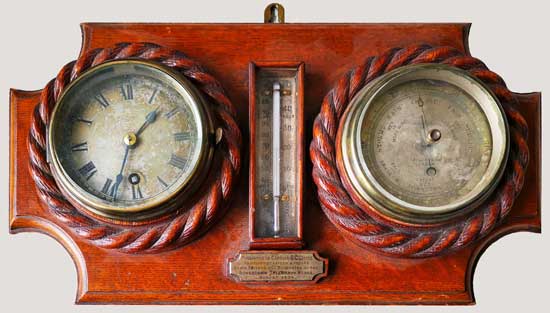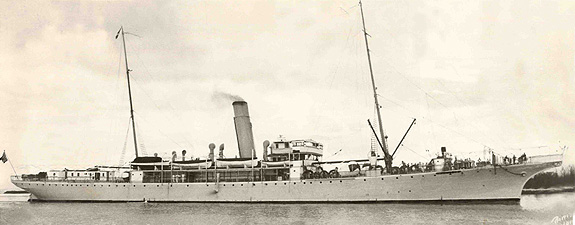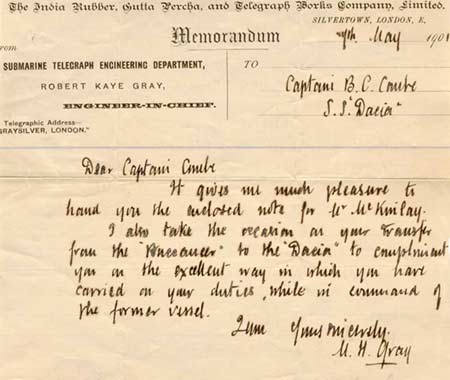History of the Atlantic Cable & Submarine Telegraphy (original) (raw)
Basil Charles Combe (1871 - 1926) served for many years on British cableships beginning in the early 1890s, eventually commanding CS Dacia and later CS Restorer, where he was captain for almost twenty years. He retired from the cable service in 1923 at age 52 and died just three years later. He is buried, together with his wife and daughter, in the Ross Bay Cemetery in Victoria, British Columbia, Canada, where his gravestone is inscribed “Erected by his Shipmates of the Cable Ship Restorer.”
Between 1886 and 1895 Combe sent letters home and kept journals of his voyages. Combe’s writing gives a riveting first-hand account of life on a cableship in the late 19th century, and is published here by kind permission of Roger Barclay, Captain Combe’s grandson.
Roger, who also made the transcription of his grandfather’s handwritten letters and journals, introduces Captain Combe as follows:
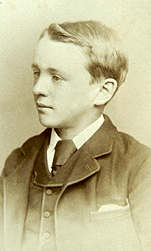
Basil Combe aged about 13, at the time of his apprenticeship on Worcester.
BASIL CHARLES COMBE
Born: June 27th 1871, in Gorleston, near Great Yarmouth, England
Died: December 27th 1926, in Victoria, BC, CanadaBasil was the second son of Col. E.H.H. Combe of Ipswich, England, being one of a family of five brothers and six sisters. He was educated at Fauconberg School, Beccles, and became a cadet, at age 14, on HMS Worcester, to train for his entry into the Merchant Service.
As an apprentice he joined the Earl Line’s 308-foot 4-masted barque, Earl of Aberdeen, on September 4th 1886 in Penarth, England, and sailed with a cargo of coal for Colombo, Ceylon, a trip of 107 days. The ship returned to Liverpool with a cargo of rice, a trip of 120 days, arriving on August 27th 1887. Combe took three more voyages aboard the Earl of Aberdeen, leaving the ship on April 4th 1890.
About the same age, wearing perhaps his Worcester uniform or possibly an apprentice uniform.
On June 16th 1890 he joined the barque Orion on her maiden voyage as Second Mate and spent the next 18 months visiting New York, Melbourne, and San Francisco, returning to Dover on December 24th, 1891.
He joined the S.S. Silvertown, under the command of Capt. A.S. Thomson, as Third Officer on April 20th 1892.
His first journal (1886 - 1893), transcribed from letters home, ends on August 2nd 1893 when the Silvertown returned to the Royal Victoria Docks and paid off the crew.
The second journal (1894 - 1895), covers a voyage aboard the S.S.Omba as Second Mate from February 1894 to October of the same year, then attaining his Master’s papers. He joined the S.S. Dacia as Chief Officer on January 9th 1895. This second journal ends on July 13th 1895 when the Dacia returned from work on the Cadiz - Teneriffe cable.
My limited research shows that my grandfather later commanded cable ships Dacia and Buccaneer prior to his taking command of Restorer in February, 1905. The period from the summer of 1895 aboard the Dacia to his retirement in 1923 is a bit of a mystery and I’d like to fill in some of the gaps. If you have any information on this part of Basil Combe’s life, please contact me through the Atlantic Cable website.
Roger Barclay, March 2003
December 2007 Research Notes:
In 1903 Basil Combe wrote a letter to the editor of The Times (London), which was published on 10 February of that year. While the letter has no cable content, being concerned with ships’ running lights, it is signed "Basil C. Combe, Master Mariner and Younger Brother of the Trinity House, Cable-ship Dacia, Gibraltar, January 23." This confirms that Basil was Master of CS Dacia in 1903.
Basil Combe took command of the Commercial Pacific Cable Company’s ship CS Restorer in early 1905, and remained with the ship until illness forced his retirement in 1923. Dirk van Oudenol’s history of CS Restorer has several mentions of Captain Combe:
“Restorer’s duty was mainly to look after the Commercial Pacific Cable, laid in 1902-03. This ran San Francisco-Honolulu-Midway-Guam-Manila, P.I. Adjacent cables were sometimes worked upon. The new cable needed little work in the early years. In about the first 10 years, Restorer’s log showed 114 days at sea, and 3,750 days at anchor in harbor, in drydock, or at dockside. The first CPCC Master was Capt. Basil Combe, who formally took command of C.S. Restorer on Jan 1, 1905.”
“Soon after Christmas [1907] they were off again for Victoria [BC, Canada]. Passengers were Capt. Combe’s wife and small daughter Vivien, with Mrs. Combe signing on as Stewardess. Arrival at Victoria was followed by the usual drydocking. After a long stay in Victoria, the blow fell on March 18, 1908. Victoria was to be the ship’s new base.”
“From March to October of 1922, the Restorer lay at anchor in Esquimalt’s harbour [BC, Canada], and while there Capt. Combe’s daughter Vivien had a birthday. This was the cause of one of the most festive parties ever held on the ship. Less than a year later Capt. Combe was taken so ill he had to leave the ship, so much joy must have been his, and Chief Steward Robb’s, during that festive evening as Paddy Herman’s Band entertained barge loads of guests ferried over from Jack Day’s wharf.
“Shortly after this great party, there was another call to tend broken cables. This time, major preparations were required, and when the ship left in late 1922, it didn’t return for 6½ months. It was during this trip that Capt. Combe’s illness forced him to leave the ship permanently.”
February 2020 Research Notes:
Site visitor Fred Cashman has kindly provided these photographs of a commemorative piece presented to Captain Combe in 1904 on the occasion of his leaving the Silvertown Telegraph Works, formally known as the India Rubber, Gutta Percha & Telegraph Works Company.
Photographs courtesy of and copyright © 2020 Fred Cashman
Mounted on an oak base are a clock, thermometer, and barometer, the two main instruments surrounded by a carved wood cable-twist moulding. A brass plaque commemorates the occasion:
Presented to Captain B.C. Combe
As a Token of Esteem and Regard
By His Friends and Shipmates of the
Silvertown Telegraph Works
August 1904
The presentation piece came down to Fred Cashman from his grandfather, who lived in the same area as Basil Combe.
Fred adds this note: ‘I don't know if my grandfather and the Captain knew each other but they certainly could have. They had common backgrounds, as my grandfather went to sea at the same time and at the same age.”
CS Restorer, photographed in Hawaii, 1922
On December 30, 1898, while Basil Combe was captain of CS Buccaneer, he wrote this postcard to his brother-in-law in London.
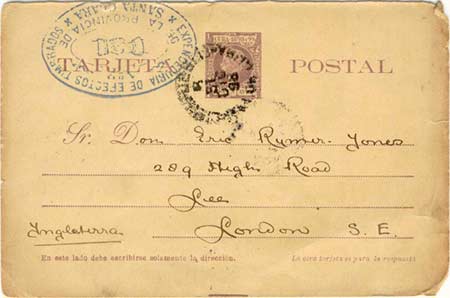 |
|---|
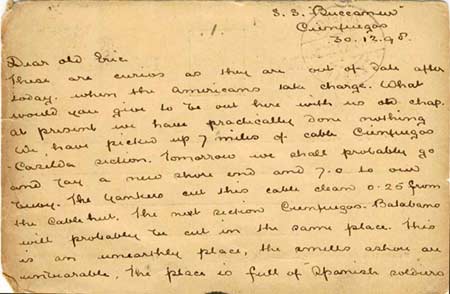 |
| S.S. "Buccaneer"Cienfuegos30.12.98. |
| Dear old Eric.These are curious as they are out of date after today when the Americans take charge. What would you give to be out here with us old chap. At present we have practically done nothing. We have picked up 7 miles of cable Cienfuegos - Casilda section. Tomorrow we shall probably go and lay a new shore end and 7.0 to our buoy. The Yankees cut this cable clean 0.25 from the cable hut. The next section Cienfuego - Balabano will probably be cut in the same place. This is an unearthly place, the smells ashore are unbearable. This place is full of Spanish soldiers. |
| Note: This cable was cut by the Americans during the Spanish-American war of 1898. For more information seen Cable-Cutting At Cienfuegos (May 11, 1898) by Lieutenant Cameron McR. Winslow and Private Hermann W Kuchmeister’s account of the Cienfuegos Cable Cutting Expedition. |
The last document concerning Captain Combe is a memo from M.H. Gray of The India Rubber, Gutta Percha, and Telegraph Works Company, Limited, dated 7th May 1901, congratulating Combe on his transfer to Dacia. This is the only documentation showing his command of both Buccaneer and Dacia.
Captain Basil Charles Combe (1871 - 1926)
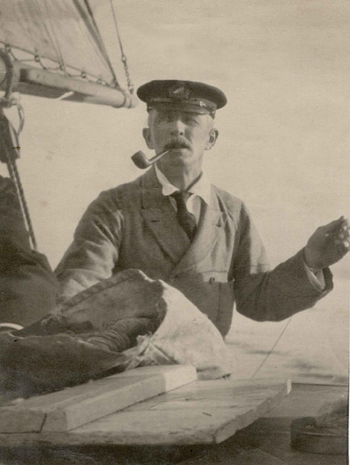
Basil Combe towards the end of his sailing career
(aged about 50). Photo taken in the 1920s in Victoria,
British Columbia, Canada, aboard his sail boat in
Esquimalt harbour. He is wearing his CPC
(Commercial Pacific Cable) hat.
